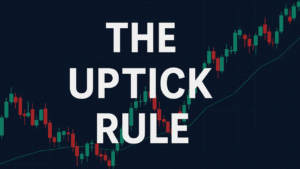 Understanding the Uptick Rule: A Safeguard Against Market Manipulation
Understanding the Uptick Rule: A Safeguard Against Market Manipulation
Short selling is a powerful tool in stock market trading, allowing investors to profit from declining prices. But when used aggressively, it can also destabilize markets and erode investor confidence. That’s where the Uptick Rule comes in—a regulatory measure designed to curb excessive downward pressure on stock prices and protect market integrity.
In this article, we’ll break down what the Uptick Rule is, why it matters, how it works today, and what traders need to know to stay compliant.
📉 What Is Short Selling?
Before diving into the Uptick Rule, let’s quickly recap short selling.
Short selling involves borrowing shares of a stock and selling them on the open market, with the intention of buying them back later at a lower price. If the stock drops, the trader profits from the difference. However, if the stock rises, the trader faces a loss.
While short selling can expose overvalued companies and improve market efficiency, it can also amplify panic during downturns—especially when traders pile on en masse.
🛡️ Enter the Uptick Rule
The Uptick Rule, originally introduced by the U.S. Securities and Exchange Commission (SEC) in 1938, was designed to prevent short sellers from accelerating a stock’s decline during volatile periods. It required that short sales be executed only on an uptick—meaning the last trade price must be higher than the previous one.
This rule ensured that short sellers could only sell into a rising market, not a falling one, helping to slow momentum-driven selloffs.
🔄 Evolution of the Rule
The original Uptick Rule stood for nearly 70 years before being repealed in 2007. However, the 2008 financial crisis reignited concerns about unchecked short selling, prompting the SEC to implement a modified version in 2010 known as Rule 201.
Key Features of Rule 201:
- Trigger Threshold: The rule activates when a stock drops 10% or more from the previous day’s closing price.
- Duration: Once triggered, the rule remains in effect for the rest of the trading day and the entire next day.
- Restriction: Short sales can only be executed at a price above the current national best bid—essentially, on an uptick.
This circuit breaker approach balances market freedom with protective oversight, activating only during significant price declines.
🧠 Why the Uptick Rule Matters
The Uptick Rule plays a critical role in maintaining market stability, especially during periods of high volatility. Here’s why it matters:
- Prevents Bear Raids: Coordinated short selling can artificially drive down prices, hurting companies and investors. The rule helps prevent this.
- Protects Retail Investors: By slowing rapid declines, it gives everyday investors time to react and reduces panic selling.
- Supports Fair Price Discovery: It ensures that price movements reflect genuine market sentiment—not manipulation.
📊 Real-World Example
Imagine Stock XYZ closes at $50. The next day, it drops to $45—a 10% decline. Rule 201 is triggered. For the rest of the day and the following day, short sellers can only execute trades above the national best bid. If the bid is $45.00, they must sell at $45.01 or higher.
This restriction doesn’t eliminate short selling—it simply ensures that it doesn’t exacerbate a freefall.
⚙️ How Traders Can Stay Compliant
If you’re actively trading or building financial tools, it’s important to understand how the Uptick Rule affects execution:
- Monitor Price Declines: Use real-time data feeds to track when a stock hits the 10% threshold.
- Adjust Algorithms: Automated trading systems should include logic to detect Rule 201 activation and route orders accordingly.
- Educate Users: If you’re developing platforms or plugins, consider embedding tooltips or FAQ sections explaining the rule’s impact on short sale orders.
🧩 Common Misconceptions
Let’s clear up a few myths:
- Myth: The Uptick Rule bans short selling.
Fact: It restricts short selling during sharp declines but doesn’t prohibit it. - Myth: It applies to all stocks at all times.
Fact: It only activates when a stock drops 10% or more in a single day. - Myth: It’s outdated and irrelevant.
Fact: Rule 201 remains a key part of the SEC’s toolkit for managing market volatility.
🔍 Uptick Rule: Final Thoughts
The Uptick Rule is more than just a technical regulation—it’s a reflection of the SEC’s commitment to fair and orderly markets. Whether you’re a trader, developer, or educator, understanding this rule helps you navigate volatility with confidence and integrity.
By embedding this knowledge into your tools, content, or trading strategies, you empower users to make informed decisions and avoid costly mistakes.